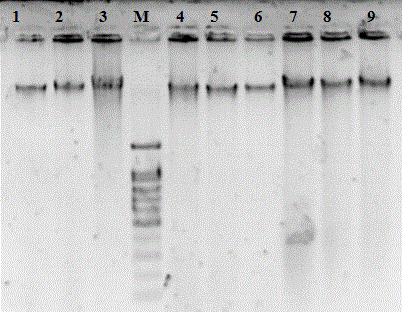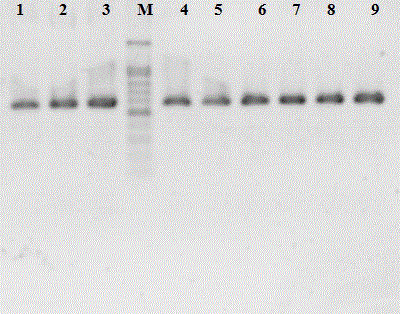Method for nondestructive extraction of rapana venosa genome DNA
A technology for the genome of the red snail, which is applied in the field of genomic DNA extraction of the red snail, can solve the problems of increasing the research cost and being unfavorable for the protection of the germplasm resources of the red snail, and achieves the protection of tissue integrity, low cost and simple operation. Effect
- Summary
- Abstract
- Description
- Claims
- Application Information
AI Technical Summary
Problems solved by technology
Method used
Image
Examples
Embodiment 1
[0021] Select 6 red snails at random from the culture pond, adopt the method of the present invention to extract genomic DNA, the specific steps are as follows: first wipe the shell mouth and the gastropods of the red snails with a cotton ball soaked in 75% alcohol for disinfection, Put the red snail in seawater with a salinity of 50ppt for 5 minutes, then take the red snail out of the seawater with a salinity of 30ppt and put it in seawater with a salinity of 30ppt for 20 minutes. Take it out from the sea water, break off the shell of the snail, gently touch the gastropod of the snail with a sterilized small stick, stimulate the snail to secrete mucus; then use a 1.5 mL centrifuge tube to collect along the shell mouth of the snail 300-500 μL of mucus; add 400 μL of extraction buffer (6 mol / L urea, 10 mmol / L Tris-HCl, 125 mmol / L NaCl, 1% SDS, 10 mmol / L NaCl to the collected snail mucus) 2 EDTA·2H 2 O, pH 7.5), 10 μL of proteinase K, mixed well, digested at 37°C for 12 h, and ...
PUM
 Login to View More
Login to View More Abstract
Description
Claims
Application Information
 Login to View More
Login to View More - R&D
- Intellectual Property
- Life Sciences
- Materials
- Tech Scout
- Unparalleled Data Quality
- Higher Quality Content
- 60% Fewer Hallucinations
Browse by: Latest US Patents, China's latest patents, Technical Efficacy Thesaurus, Application Domain, Technology Topic, Popular Technical Reports.
© 2025 PatSnap. All rights reserved.Legal|Privacy policy|Modern Slavery Act Transparency Statement|Sitemap|About US| Contact US: help@patsnap.com



